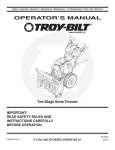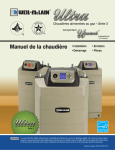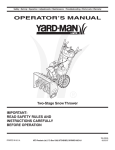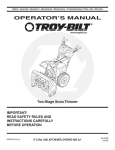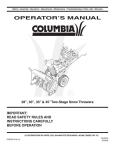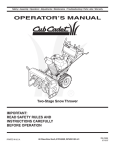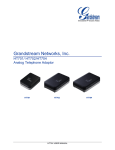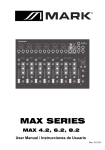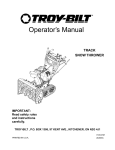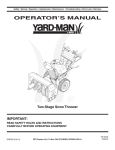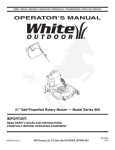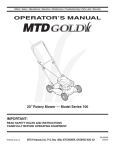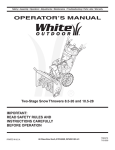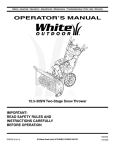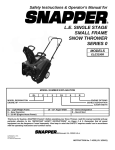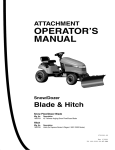Download Troy-Bilt 769-04090 User's Manual
Transcript
Safety • Set-Up • Operation • Adjustments • Maintenance • Troubleshooting • Parts Lists • Warranty OPERATOR’S MANUAL www.troybilt.ca Two-Stage Snow Thrower IMPORTANT: READ SAFETY RULES AND INSTRUCTIONS CAREFULLY BEFORE OPERATING EQUIPMENT. PRINTED IN U.S.A. P. O. Box 1386, KITCHENER, ONTARIO N2G 4J1 769-04090 06/10/08 This Operator’s Manual is an important part of your new snow thrower. It will help you assemble, prepare and maintain the unit for best performance. Please read and understand what it says. Table of Contents Safety Symbols.................................................... 3 Safe Operation Practices.................................... 4 Setting Up Your Snow Thrower........................... 6 Operating Your Snow Thrower.......................... 10 MakingAdjustments.......................................... 14 Maintaining Your Snow Thrower....................... 16 Off-Season Storage........................................... 20 Trouble Shooting............................................... 21 Warranty............................................................. 22 Illustrated Parts Lists........................................ 24 Finding and Recording Model Number BEFORE YOU START ASSEMBLING YOUR NEW EQUIPMENT, please locate the model plate on the equipment and copy the model number and the serial number to the sample model plate provided to the right. You can locate the model plate by standing at the operating position and looking down at the frame. -ODEL.UMBER .UM£RODEMODÞLE 888888888 3ERIAL.UMBER .UM£RODES£RIE 88888888888 42/9"),4#!.!$! +)4#(%.%2/..'* Customer Support Please do NOT return the unit to the retailer from which it was purchased, without first contacting Customer Support. If you have difficulty assembling this product or have any questions regarding the controls, operation or maintenance of this unit, you can seek help from the experts. Choose from the options below: 1. Visit www.troybilt.ca/troybilt for many useful suggestions. 2. Call an authorized dealer or Customer Support Representative at 1-800-668-1238. 3. The engine manufacturer is responsible for all engine-related issues in terms of performance, power-rating, specifications, warranty, and service. Depending on the engine manufacturer, more information is included in this publication or packed separately with this product. Please have your unit’s model number and serial number ready when you call. See previous section to locate this information. You will be asked to enter the serial number in order to process your call. 2 This page depicts and describes safety symbols that may appear on this product. Read, understand, and follow all instructions on the machine before attempting to assemble and operate. Symbol Description READ THE OPERATOR’S MANUAL(S) Read, understand, and follow all instructions in the manual(s) before attempting to assemble and operate. 1 Safety Symbols WARNING— ROTATING BLADES Keep hands out of inlet and discharge openings while machine is running. There are rotating blades inside. WARNING— ROTATING BLADES Keep hands out of inlet and discharge openings while machine is running. There are rotating blades inside. WARNING— ROTATING AUGER Do not put hands or feet near rotating parts, in the auger/impeller housing or chute assembly. Contact with the rotating parts can amputate hands and feet. WARNING—THROWN OBJECTS This machine may pick up and throw and objects which can cause serious personal injury. WARNING—GASOLINE IS FLAMMABLE Allow the engine to cool at least two minutes before refueling. WARNING— CARBON MONOXIDE Never run an engine indoors or in a poorly ventilated area. Engine exhaust contains carbon monoxide, an odorless and deadly gas. WARNING— ELECTRICAL SHOCK Do not use the engine’s electric starter in the rain. WARNING This symbol points out important safety instructions which, if not followed, could endanger the personal safety and/or property of yourself and others. Read and follow all instructions in this manual before attempting to operate this machine. Failure to comply with these instructions may result in personal injury. When you see this symbol, HEED ITS WARNING! Your Responsibility Restrict the use of this power machine to persons who read, understand and follow the warnings and instructions in this manual and on the machine. 3 2 Safe Operation Practices WARNING This symbol points out important safety instructions which, if not followed, could endanger the personal safety and/or property of yourself and others. Read and follow all instructions in this manual before attempting to operate this machine. Failure to comply with these instructions may result in personal injury. When you see this symbol, HEED ITS WARNING! Your Responsibility Restrict the use of this power machine to persons who read, understand and follow the warnings and instructions in this manual and on the machine. WARNING: Engine Exhaust, some of its constituents, and certain vehicle components contain or emit chemicals known to State of California to cause cancer and birth defects or other reproductive harm. DANGER: This machine was built to be operated according to the safe operation practices in this manual. As with any type of power equipment, carelessness or error on the part of the operator can result in serious injury. This machine is capable of amputating hands and feet and throwing objects. Failure to observe the following safety instructions could result in serious injury or death. Training Safe Handling of Gasoline 1. Read, understand, and follow all instructions on the machine and in the manual(s) before attempting to assemble and operate. Keep this manual in a safe place for future and regular reference and for ordering replacement parts. 2. Be familiar with all controls and their proper operation. Know how to stop the machine and disengage them quickly. 3. Never allow children under 14 years old to operate this machine. Children 14 years old and over should read and understand the instructions and safe operation practices in this manual and on the machine and be trained and supervised by an adult. 4. Never allow adults to operate this machine without proper instruction. 5. Thrown objects can cause serious personal injury. Plan your snow-throwing pattern to avoid discharge of material toward roads, bystanders and the like. 6. Keep bystanders, helpers, pets and children at least 75 feet from the machine while it is in operation. Stop machine if anyone enters the area. 7. Exercise caution to avoid slipping or falling, especially when operating in reverse. To avoid personal injury or property damage use extreme care in handling gasoline. Gasoline is extremely flammable and the vapors are explosive. Serious personal injury can occur when gasoline is spilled on yourself or your clothes, which can ignite. Wash your skin and change clothes immediately. Preparation Thoroughly inspect the area where the equipment is to be used. Remove all doormats, newspapers, sleds, boards, wires and other foreign objects, which could be tripped over or thrown by the auger/impeller. 1. Always wear safety glasses or eye shields during operation and while performing an adjustment or repair to protect your eyes. Thrown objects which ricochet can cause serious injury to the eyes. 2. Do not operate without wearing adequate winter outer garments. Do not wear jewelry, long scarves or other loose clothing, which could become entangled in moving parts. Wear footwear which will improve footing on slippery surfaces. 3. Use a grounded three-wire extension cord and receptacle for all units with electric start engines. 4. Adjust collector housing height to clear gravel or crushed rock surfaces. 5. Disengage all control levers before starting the engine. 6. Never attempt to make any adjustments while engine is running, except where specifically recommended in the operator’s manual. 7. Let engine and machine adjust to outdoor temperature before starting to clear snow. 4 a. Use only an approved gasoline container. b. Extinguish all cigarettes, cigars, pipes and other sources of ignition. c. Never fuel machine indoors. d. Never remove gas cap or add fuel while the engine is hot or running. e. Allow engine to cool at least two minutes before refueling. f. Never over fill fuel tank. Fill tank to no more than ½ inch below bottom of filler neck to provide space for fuel expansion. g. Replace gasoline cap and tighten securely. h. If gasoline is spilled, wipe it off the engine and equipment. Move machine to another area. Wait 5 minutes before starting the engine. i. Never store the machine or fuel container inside where there is an open flame, spark or pilot light (e.g. furnace, water heater, space heater, clothes dryer etc.). j. Allow machine to cool at least 5 minutes before storing k. Never fill containers inside a vehicle or on a truck or trailer bed with a plastic liner. Always place containers on the ground away from your vehicle before filling. l. If possible, remove gas-powered equipment from the truck or trailer and refuel it on the ground. If this is not possible, then refuel such equipment on a trailer with a portable container, rather than from a gasoline dispenser nozzle. m.Keep the nozzle in contact with the rim of the fuel tank or container opening at all times until fueling is complete. Do not use a nozzle lock-open device. Operation Maintenance & Storage 1. Do not put hands or feet near rotating parts, in the auger/ impeller housing or chute assembly. Contact with the rotating parts can amputate hands and feet. 2. The auger/impeller control lever is a safety device. Never bypass its operation. Doing so makes the machine unsafe and may cause personal injury. 3. The control levers must operate easily in both directions and automatically return to the disengaged position when released. 4. Never operate with a missing or damaged chute assembly. Keep all safety devices in place and working. 5. Never run an engine indoors or in a poorly ventilated area. Engine exhaust contains carbon monoxide, an odorless and deadly gas. 6. Do not operate machine while under the influence of alcohol or drugs. 7. Muffler and engine become hot and can cause a burn. Do not touch. 8. Exercise extreme caution when operating on or crossing gravel surfaces. Stay alert for hidden hazards or traffic. 9. Exercise caution when changing direction and while operating on slopes. 10.Plan your snow-throwing pattern to avoid discharge towards windows, walls, cars etc. Thus, avoiding possible property damage or personal injury caused by a ricochet. 11.Never direct discharge at children, bystanders and pets or allow anyone in front of the machine. 12.Do not overload machine capacity by attempting to clear snow at too fast of a rate. 13.Never operate this machine without good visibility or light. Always be sure of your footing and keep a firm hold on the handles. Walk, never run. 14.Disengage power to the auger/impeller when transporting or not in use. 15.Never operate machine at high transport speeds on slippery surfaces. Look down and behind and use care when backing up. 16.If the machine should start to vibrate abnormally, stop the engine, disconnect the spark plug wire and ground it against the engine. Inspect thoroughly for damage. Repair any damage before starting and operating. 17.Disengage all control levers and stop engine before you leave the operating position (behind the handles). Wait until the auger/impeller comes to a complete stop before unclogging the chute assembly, making any adjustments, or inspections. 18.Never put your hand in the discharge or collector openings. Always use the clean-out tool provided to unclog the discharge opening. Do not unclog chute assembly while engine is running. Shut off engine and remain behind handles until all moving parts have stopped before unclogging. 19.Use only attachments and accessories approved by the manufacturer (e.g. wheel weights, tire chains, cabs etc.). 20.When starting engine, pull cord slowly until resistance is felt, then pull rapidly. Rapid retraction of starter cord (kickback) will pull hand and arm toward engine faster than you can let go. Broken bones, fractures, bruises or sprains could result. 21.If situations occur which are not covered in this manual, use care and good judgment. Call customer assistance for the name of your nearest servicing dealer. 1. Never tamper with safety devices. Check their proper operation regularly. Refer to the maintenance and adjustment sections of this manual. 2. Before cleaning, repairing, or inspecting machine disengage all control levers and stop the engine. Wait until the auger/ impeller come to a complete stop. Disconnect the spark plug wire and ground against the engine to prevent unintended starting. 3. Check bolts and screws for proper tightness at frequent intervals to keep the machine in safe working condition. Also, visually inspect machine for any damage. 4. Do not change the engine governor setting or over-speed the engine. The governor controls the maximum safe operating speed of the engine. 5. Snow thrower shave plates and skid shoes are subject to wear and damage. For your safety protection, frequently check all components and replace with original equipment manufacturer’s (OEM) parts only. “Use of parts which do not meet the original equipment specifications may lead to improper performance and compromise safety!” 6. Check controls periodically to verify they engage and disengage properly and adjust, if necessary. Refer to the adjustment section in this operator’s manual for instructions. 7. Maintain or replace safety and instruction labels, as necessary. 8. Observe proper disposal laws and regulations for gas, oil, etc. to protect the environment. 9. Prior to storing, run machine a few minutes to clear snow from machine and prevent freeze up of auger/impeller. 10.Never store the machine or fuel container inside where there is an open flame, spark or pilot light such as a water heater, furnace, clothes dryer etc. 11.Always refer to the operator’s manual for proper instructions on off-season storage. 12.Check fuel line, tank, cap, and fittings frequently for cracks or leaks. Replace if necessary. 13.Do not crank engine with spark plug removed. Do not modify engine To avoid serious injury or death, do not modify engine in any way. Tampering with the governor setting can lead to a runaway engine and cause it to operate at unsafe speeds. Never tamper with factory setting of engine governor. Notice regarding Emissions Engines which are certified to comply with California and federal EPA emission regulations for SORE (Small Off Road Equipment) are certified to operate on regular unleaded gasoline, and may include the following emission control systems: Engine Modification (EM) Oxidizing Catalyst (OC), Secondary Air Injection (SAI) and Three Way Catalyst (TWC) if so equipped. Average Useful Life According to the Consumer Products Safety Commission (CPSC) and the U.S. Environmental Protection Agency (EPA), this product has an Average Useful Life of seven (7) years, or 60 hours of operation. At the end of the Average Useful Life, have the machine inspected annually by an authorized service dealer to ensure that all mechanical and safety systems are working properly and not worn excessively. Failure to do so can result in accidents, injuries or death. 05.08.08 5 2 Safe Operation Practices WARNING This symbol points out important safety instructions, which if not followed, could endanger the personal safety and/or property of yourself and others. Read and follow all instructions in this manual before attempting to operate this machine. Failure to comply with these instructions may result in personal injury. When you see this symbol, HEED IT’S WARNING! Your Responsibility Restrict the use of this power machine to persons who read, understand and follow the warnings and instructions in this manual and on the machine. 3 IMPORTANT: The snow thrower is shipped with oil and WITHOUT GASOLINE. After assembly, refer to separate engine manual for proper fuel and engine oil recommendations. Loose Parts Setting Up Your Snow Thrower • The augers are secured to the auger shaft with shear pins and bow tie cotter pins. If you hit a foreign object or ice jam, the snow thrower is designed so that the pins may shear. Replacement shear pins and cotter pins are provided for your convenience. Store these safely until needed. Items Required For Assembly Pair of pliers Fresh gasoline 7/16” Wrenches or adjustables Figure 3-1 NOTE: This Operator’s Manual covers several models. Snowthrower featrues vary by model. Not all features referenced in this manual are applicable to all snowthrower models. NOTE: References to right or left side of the snow thrower are determined from behind the unit in the operating position. Assembling Handle • Look at the lower rear of the snow thrower frame to be sure the spring (found at the end of each cable) is attached to its actuator bracket. • Remove the lower handle knobs, washers and carriage bolts from each side of the upper handle. See Figure 3-2. • Raise the upper handle assembly until it locks over the lower handle. See Figure 3-1. • Secure the upper handle and lower handle with the handle knobs and carriage bolts previously removed. • Tighten the handle knobs already in place on the upper holes and secure the handles firmly. Figure 3-2 NOTE: Replacement auger shear pins and cotter pins are provided for your convenience. Store these safely until needed. Attaching Chute Crank • Remove the hairpin clip from the upper chute crank and slide the upper chute crank into the lower chute crank. A pair of pliers may help in this job. See Figure 3-3. a. Align the two holes on both chute cranks. See Figure 3-3. a b. Secure with the hairpin clip removed earlier. b Figure 3-3 6 3 Setting Up Your Snow Thrower Figure 3-4 Figure 3-5 Attaching the Chute Assembly • Remove locknuts and screws securing one of the flange keepers to the chute assembly. See Figure 3-4. WARNING • Loosen but do not remove the locknuts and screws on the other two flange keepers. Prior to operating your snow thrower, refer to Auger Control on page 9. Read and follow all instructions carefully and perform all adjustments to verify your unit is operating safely and properly. • Slide chute assembly over chute opening, making sure the flange keepers are beneath lip of chute adapter. The notches should engage with the spiral end of the chute crank. See Figure 3-5. • Secure flange keeper, locknuts and screws previously removed. Tighten all flange keepers and hardware with two 7/16” wrenches. Do not over tighten. NOTE: If necessary the chute crank support bracket can be adjusted so the spiral on the chute crank fully engages the teeth on the chute assembly. Refer to the Adjustment Section. Attaching the Shift Rod • Align the upper and lower shift rods, then slide the shift rod connector down over the end of the lower shift rod. Tap the connector until the lower rod is completely through the connector. See Figure 3-6. Figure 3-6 NOTE: If the connector is not properly assembled, the shift rod will pivot and you will not be able to change speeds or direction. NOTE: If the full range of speeds (forward and reverse) cannot be achieved, refer to the Adjustment Section. • Normally the cable ties holding the steering cables against the handle are loosely installed on each side of the lower handle at the factory. Pull the cable ties tight to secure. Cut the excess from the ends of cable ties. • If not already attached, slip the cables that run from the handle panel to the discharge chute into the cable guide. See Figure 3-7. Figure 3-7 7 3 Lamp Wiring Drift Cutters (If Equipped) • Wrap the wire from the head lamp down the right handle until the wire can be plugged into the alternator lead wire under the fuel tank. See Figure 3-8. Drift cutters should be used when operating the snow thrower in heavy drift conditions. Setting Up Your Snow Thrower • On models so equipped, drift cutters and hardware are assembled to the auger housing inverted. • Remove the carriage bolts and wingnuts securing the drift cutters to the housing. Alternator Lead • Reposition drift cutters so they face forward as shown in Figure 3-9. Secure with hardware previously removed, wingnuts should be fastened on the outside of the housing as shown. Alternator Lead If your unit is not equipped with drift cutters, you may contact Customer Support as instructed on page 2 for information regarding price and availability. Lamp Wire NOTE: Wheels are omitted from illustration for clarity. Figure 3-8 Snowthrower Model Drift Cutter Kit: All models OEM-390-679 Clean-Out Tool WARNING The clean-out tool is mounted to the rear of the auger housing and is designed to clear a clogged chute. See Figure 3-10. Refer to the Operation section for more detailed information regarding the chute clean-out tool. Never use your hands to clean snow and ice from the chute assembly or auger housing. NOTE: This item is fastened with a cable tie to the rear of the auger housing at the factory. Cut the cable tie before operating the snow thrower. WARNING: Never use your hands to clean snow and ice from the chute assembly or auger housing. Final Adjustments IMPORTANT Under any circumstance do not exceed manufacturer’s recommended psi. Equal tire pressure should be maintained at all times. Excessive pressure when seating beads may cause tire/rim assembly to burst with force sufficient to cause serious injury. Refer to sidewall of tire for recommended pressure. Make these final adjustments before operating your snow thrower for the first time. Failure to follow these instructions may cause damage to the snow thrower. Figure 3-9 Wheel Drive Control & Shift Lever Perform the following test to determine need for adjustment: • Move the shift lever into sixth (6) position. See Figure 3-14. Clean-Out Tool • With the drive control released (see Figure 3-11A), push the snow thrower forward, then pull it back. The machine should move freely. • Engage the drive control and attempt to move the machine both forward and back, resistance should be felt. • Move the shift lever into the fast reverse (R2) position and repeat the previous two steps. If you experienced resistance rolling the unit, either when repositioning the shift lever from 6 to R2 or when attempting to move the machine with the drive control released, adjust the drive control immediately. To adjust, proceed as follows: Figure 3-10 8 3 B A A Auger Drive Setting Up Your Snow Thrower Figure 3-11 • Loosen the Nylock nut on the drive control cable and unthread the cable one full turn. See Figure 3-13. B • Recheck adjustment. A - For models with steel panels. B - For models with plastic panels. • Retighten the Nylock nut to secure the cable when correct adjustment is reached. Figure 3-12 NOTE: For more details, refer to Drive Control Adjustment in the Adjustment Section of this manual. WARNING Auger Control Check the adjustment of the auger control as follows: Never use your hands to clean snow and ice from the chute assembly or auger housing. • When the auger control is released and in the disengaged “up” position (see Figure 3-11B), the cable should have very little slack, but should NOT be tight. See Figure 3-12. WARNING:Do not over-tighten the cable. Over-tightening may prevent the auger from disengaging and compromise the safety of the snow thrower. • In a well-ventilated area, start the snow thrower engine as instructed on page 12. • While standing in the operator’s position (behind the snow thrower) engage the auger. • Allow the auger to remain engaged for approximately ten seconds before releasing the auger control. Repeat this several times. • With the auger control lever in the disengaged “up” position, walk to the front of the machine. • Confirm that the auger has completely stopped rotating and shows no signs of motion. IMPORTANT: If the auger shows any signs of rotating, immediately return to the operator’s position and shut off the engine. Wait for all moving parts to stop before readjusting the auger control cable. Figure 3-13 • Repeat auger control test to verify for proper adjustment. Repeat previous steps to adjust more, if necessary. Skid Shoes Position the skid shoes based on surface conditions. Adjust upward for hard-packed snow. Adjust downward when operating on gravel or crushed rock surfaces. See “Making Adjustment” Section. Tire Pressure (Pneumatic Tires) The tires are over-inflated for shipping purposes. Check the tire pressure before operating the snow thrower. Refer to the tire side wall for tire manufacturer’s • To readjust the control cable, unhook the spring (found recommended psi and deflate (or inflate) the tires as on the end of the auger cable) from the auger actuator necessary. bracket. See Figure 3-12. • Push the cable coupler through the end of the spring to expose the lock nut. See Figure 3-13. • Thread the Nylock nut outward (down the coupler) three full turns to provide more slack in the cable and reattach the spring to the bracket. 9 IMPORTANT If the tire pressure is not equal in both tires, the unit may not travel in a straight path and the shave plate may wear unevenly. 4 Know Your Snow Thrower Shift Lever Drive Control Operating Your Snow Thrower Two-Way Chute Control™ Headlight Auger Control Wheel Steering Control Chute Assembly Chute Direction Control Clean-Out Tool Choke Control Engine Controls Gas Cap Primer Oil Fill Electric Start Button (optional) WARNING Read, understand, and follow all instructions and warnings on the machine and in this manual before operating. Use extreme care when handling gasoline. Gasoline is extremely flammable and the vapors are explosive. Never fuel the machine indoors or while the engine is hot or running. Extinguish cigarettes, cigars, pipes and other sources of ignition. Safety Key Augers Skid Shoe Recoil Starter Handle Rocker Switch Electric Starter Outlet (optional) Figure 4-1 Now that you have set up your snow thrower for operation, get acquainted with its controls and features. These are described below and illustrated on this page. This knowledge will allow you to use your new equipment to its fullest potential. NOTE: For detailed starting instructions and more information on all engine controls, refer to the separate engine manual packed with your unit. Choke Control The choke control is found on top of the engine and is activated by rotating the knob counter clockwise. Activating the choke control closes the choke plate on the carburetor and aids in starting the engine. Primer Depressing the primer forces fuel directly into the engine’s carburetor to aid in cold-weather starting. Shift Lever The shift lever is located in the center of the handle panel and is used to determine ground speed and direction of travel. It can be moved into any of eight positions. 6 IMPORTANT: Always release drive control before changing speeds. 2 1 Forward: The snow thrower has six forward (F) speeds. Position one (1) is the slowest and position six (6) is the fastest. Reverse: The snow thrower has two reverse (R) speeds—R1 is the slower of the two. Oil Fill Engine oil level can be checked and oil added through the oil fill. 5 4 Safety Key The safety key must be pushed in place in order for the engine to start. Pull the safety key out to prevent unauthorized use of equipment. 3 F Rocker Switch The rocker switch is used to stop the engine. The switch must be in the “ON” position in order to start the engine. R R1 R2 10 Auger Control The auger control is located on the left handle. Squeeze the auger control to engage the augers. Release to stop the snow throwing action. The drive control must also be released in order to stop auger. Two-Way Chute Control™) This two-way control lever is meant to control the distance of snow discharge from the chute. Tilt the lever forward or rearward to adjust the distance snow will be thrown. !5'%2 #/.42/, Chute Directional Control The chute directional control is located on left side of the snow thrower. To change the direction in which snow is thrown, turn chute directional control as follows: • Crank clockwise to discharge to the left. '/ CLOCKWISE TO DISCHARGE LEFT COUNTER CLOCKWISE TO DISCHARGE RIGHT 4 Operating Your Snow Thrower • Crank counterclockwise to discharge to the right. Drive Control / Auger Control Lock The drive control is located on the right handle. Squeeze the drive control to engage the wheel drive. Release to stop. This same lever also locks the auger control so you can operate the chute crank without interrupting the snow throwing process. If the auger control is engaged simultaneously with the drive control, the operator can release the auger control (on the left handle) and the augers will remain engaged. Release the drive control to stop the augers and wheel drive (the auger control must also be released). Wheel Steering Controls The left and right wheel steering controls are located on the underside of the handles. Squeeze the right control to turn right; squeeze the left control to turn left. NOTE: Operate the snow thrower in open areas until you are familiar with these controls. IMPORTANT: NEVER reposition the shift lever (change speeds or direction of travel) without first releasing the drive control and bringing the snow thrower to a complete stop. Doing so will result in premature wear to the snow thrower’s drive system. $2)6% #/.42/, Chute Clean-Out Tool WARNING: Never use your hands to clear a clogged chute assembly. Shut off engine and remain behind handles until all moving parts have stopped before unclogging. The clean-out tool is conveniently fastened to the rear of the auger housing with a mounting clip. 1. Release both the auger control and the drive/auger control lock. 2. Stop the engine by pushing the rocker switch to the “OFF” position, pull out the safety key. 3. Remove the clean-out tool from the mounting clip. 4. Use the shovel-shaped end of the clean-out tool to remove any snow and ice in the chute assembly. '/ 5. Re-fasten the clean-out tool to the mounting clip on the rear of the auger housing and restart engine. 6. While standing in the operator’s position (behind the snow thrower), engage the auger control for a few seconds to clear any remaining snow or ice from the chute assembly before continuing to clear snow. Skid Shoes Position the skid shoes based on surface conditions. Adjust upward for hard-packed snow. Adjust downward when operating on gravel or crushed rock surfaces. See “Making Adjustment” Section. Headlight The headlight is on whenever the engine is running. 11 WARNING The operation of any snow thrower can result in foreign objects being thrown into the eyes, which can damage your eyes severely. Always wear safety glasses while operating the snow thrower, or while performing any adjustments or repairs on it. Be sure no one other than the operator is standing near the snow thrower while starting engine or operating snow thrower. Never run engine indoors or in enclosed, poorly ventilated areas. Engine exhaust contains carbon monoxide, an odorless and deadly gas. Keep hands, feet, hair and loose clothing away from any moving parts on engine and snow thrower. 4 Operating Your Snow Thrower Gas & Oil Fill-Up Service the engine with gasoline and oil as instructed in the separate engine manual packed with your unit. Read instructions carefully. Starting The Engine 1. Make certain both the auger control and drive control are in the disengaged (released) position. 2. Open fuel shut-off valve (If equipped) and make sure the Rocker switch is in the On position (if equipped). 3. Push in the safety key. 4. Rotate choke control to FULL choke position (for a cold engine start). WARNING Read, understand, and follow all instructions and warnings on the machine and in this manual before operating. Use extreme care when handling gasoline. Gasoline is extremely flammable and the vapors are explosive. Never fuel the machine indoors or while the engine is hot or running. Extinguish cigarettes, cigars, pipes and other sources of ignition. NOTE: If the engine is already warm, place choke co
























































